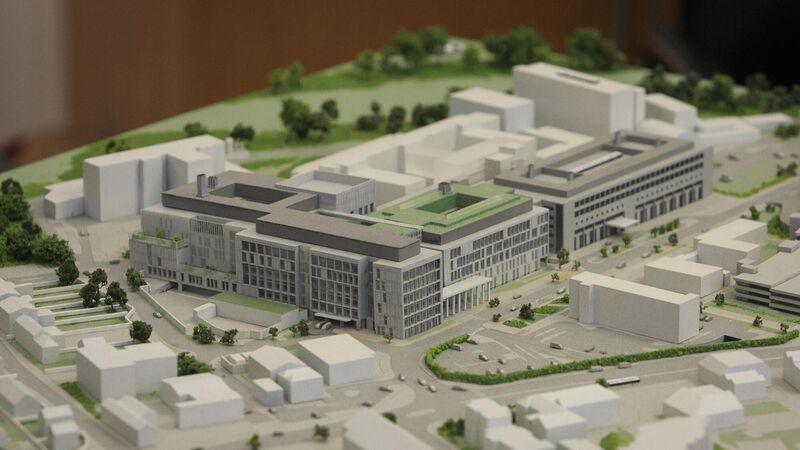Marie O'Connor: We need full public ownership of the new National Maternity Hospital

A model of the new National Maternity Hospital on the St Vincent's campus to mark the submission of the planning application for the new National Maternity Hospital. Picture: Gareth Chaney Collins
Until a couple of weeks ago, the Religious Sisters of Charity owned three hospitals: St Vincent’s University Hospital, St Vincent's Private Hospital, and St Michael’s Hospital in Dun Laoghaire.
The sisters also owned the Elm Park and Dun Laoghaire sites of these facilities. The Elm Park lands in Dublin 4, a sprawling 28.7 acres, are among the most valuable in the country. The assets of the order were valued at €661m in 2018.
These assets have just been transferred to the nuns’ new vehicle, St Vincent’s Holdings — effectively a spin-off of the company formerly owned by the congregation, St Vincent’s Healthcare Group.
One aspect of the Vincent’s healthcare enterprise that has received little attention is the group’s overseas ambitions. The constitution of St Vincent’s Holdings references the company’s intention to build links with international organisations.
For example, although it is usual to own the land on which you intend to build, the State seems determined to build on land it does not own.
The new build — cleverly branded as the National Maternity Hospital at Elm Park DAC — is estimated to cost in or around €1bn to construct, fit-out and equip.
Until a couple of weeks ago, the site for the new NMH was owned by the Religious Sisters of Charity. The transfer of the nuns’ assets into this private holding company required Vatican approval. Whether Vatican approval is needed before Vincent’s can finalise the lease to be offered to the Government is a known unknown, as a footnote to a newly published document suggests.
Vincent’s used their ownership of the land to force the Department of Health to grant it an operating license. The purpose of the license is to enable Vincent’s to control the use of the land, and, by extension, the activities of the new facility. This operating license effectively vitiates the ownership that would otherwise attach to a 299-year lease.
If the Government signs on the dotted line, all the State will own is the shell of the new building.
The Holles Street hospital company is being dissolved to facilitate this. The National Maternity Hospital at Elm Park DAC will be a wholly-owned subsidiary of St Vincent’s Holdings and St Vincent’s Healthcare Group. Wholly-owned subsidiaries are wholly controlled by their parent companies. Both of these companies are successor bodies to the Religious Sisters of Charity.
The HSE has just published what purports to be "a full set of legal documents" in connection with the State’s proposed investment. Some are missing from the bundle, even on the face of it. Within the bundle itself, there are unacceptable blanks — missing maps and schedules.
Reading through this blizzard of legalese, what comes across is an anxiety to convince the concerned: taxpayers who are paying for this new build and members of the Oireachtas, including ministers, that the new maternity hospital, as planned, will somehow, miraculously, be independent.
The operating license is, somehow, to be ‘shared’ between St Vincent’s Healthcare Group and the new hospital company (that is, let’s not forget, its wholly-owned subsidiary).
In yet another layer of control, St Vincent’s Healthcare Group is defined as a member of the new hospital company (along with the Minister for Health). But Vincent’s holds all the cards.
Missing from the purported legal framework are the constitutions that define Vincent’s control over the new facility and enshrine its Catholic ethos.
These, the constitutions of St Vincent’s Holdings and St Vincent’s Healthcare Group, contradict in key respects what is contained or implied in the official bundle.
Under the amended constitution of St Vincent’s Healthcare Group, for example, the new maternity hospital company will be just another Vincent’s hospital, to be managed in exactly the same way as Vincent’s existing hospitals.
This micromanagement extends to providing for and laying down "plans, procedures, requirements, rules, and regulations for accounting (financial or otherwise), discipline, education, staffing, teaching, patient care, patient records, purchasing, research, medical, nursing, and surgical services, and treatment of all kinds in the facilities".
The Main Object of both constitutions ties the provision of healthcare services to ethical compliance.
International and national guidelines on ‘best practice’ have been substituted for the ethical code and philosophy of the Religious Sisters of Charity.
Theologians in both Rome and Armagh have satisfied themselves on this critical point.
This Main Object is overarching, and will supersede, legally, all assurances given to the contrary. Given that Church teaching prohibits procedures such as assisted fertility and abortion, unless the mother’s life is at risk, concerns that the ethos of the new hospital will limit the provision of such services are well-founded.
Under the constitution of the National Maternity Hospital at Elm Park DAC (just published), the company is empowered to carry on its business "in any part of the world".
This seems like a bit of a stretch for what is to be a publicly funded asset.
It ties in with the constitution of St Vincent's Holdings, which, on the very last page, names as subscribers to the company two offshore specialists: Stembridge Ltd and Porema Ltd. These offshore intermediaries are linked to over 200,000 offshore entities, many of which feature in the Panama Papers.
That these assets, on current plans, are set to include the new maternity facility, is disquieting in view of the recent example set by the Bon Secours.
Only full public ownership of the new National Maternity Hospital can surmount these seemingly otherwise insurmountable barriers, guarantee the provision of services prohibited by Rome for future generations, and safeguard the enormous public investment in the new facility for today's taxpayers.













